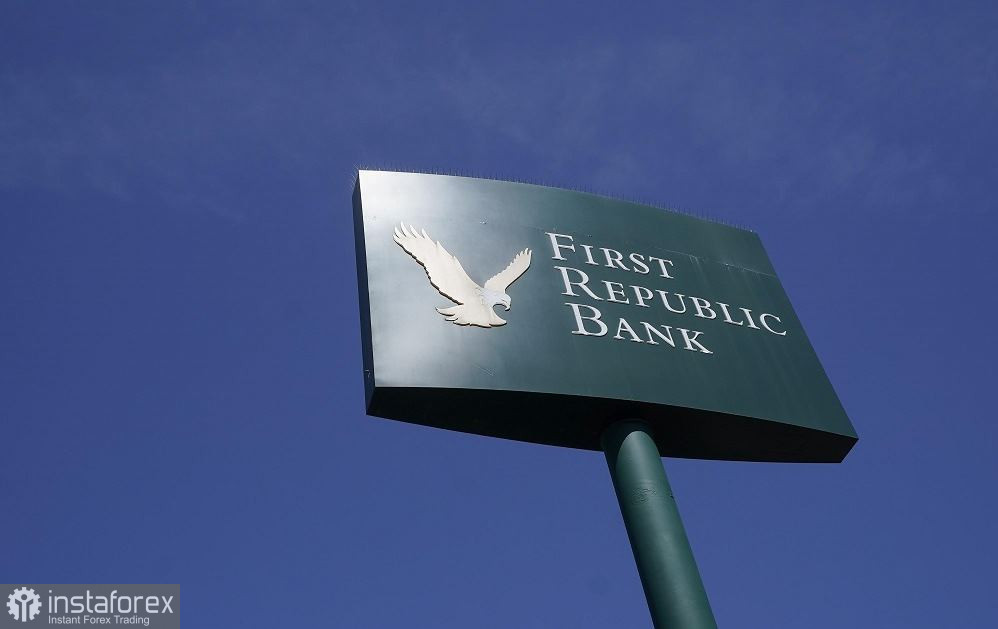The currency pair started the trading week with a minor northward gap, but as the Asian session unfolded, EUR/USD bears took charge, dragging the pair back towards the 1.0900 area. Nonetheless, the pair essentially remains in a sideways channel, constrained between 1.0960 and 1.1070. The mixed fundamental backdrop hampers traders from making any substantial moves in either direction. Last week's key data releases (US GDP, Eurozone GDP, Core PCE Index, Germany's CPI) generated more uncertainty than clarity. Traders are in dire need of guidance as the market lies dormant, awaiting May's European Central Bank and Federal Reserve meetings, where officials will interpret recent reports in light of possible future monetary policy tightening measures.
May Day and First Republic Bank takeover
Today, several European nations observe May Day, with festivities taking place in countries like Germany, Spain, France, Italy, and Switzerland. As a result, current EUR/USD price fluctuations primarily reflect shifts in the US Dollar Index, which resumed its upward momentum during the European trading session. One driving factor behind DXY's upsurge is the recent acquisition of the prominent American financial institution, First Republic Bank. Ranking among the top 20 US banks, First Republic Bank's total assets reached $229 billion, with deposits amounting to $104 billion as of April 13.

Although the rescue operation is not yet complete, recent developments suggest a high probability of a happy ending, if one can speak of a favorable outcome in such situations. Over the weekend, US media reported that more than ten banks, including Citizens Financial Group, JPMorgan, and PNC Financial Services Group, submitted bids to acquire First Republic Bank. Today, it was announced that First Republic Bank has been handed over to regulators and will be acquired by JPMorgan Chase & Co. According to representatives of the California Department of Financial Protection and Innovation (CDFPI), JPMorgan will assume all deposits, including all uninsured deposits, and virtually all assets of the defunct bank.
The recent banking crisis seems to have subsided. However, First Republic's bankruptcy will not go unnoticed, particularly by dollar bulls. After all, the failure of a major US bank is a direct consequence of the Federal Reserve's aggressive policy. According to Forbes, due to the increase in the Fed funds rate last year, First Republic's mortgage portfolio, valued at $138 billion at the beginning of the year, fell by $19 billion.
Taking into account the bank failures of March and April, it can be assumed that the Federal Reserve will not announce further monetary policy tightening measures at its May meeting, although it is highly likely to raise interest rates by 25 basis points. According to the CME FedWatch Tool, the probability of a 25 bps hike is currently estimated at 90%, with a 70% probability of the interest rate being unchanged in June.
Market in wait-and-see mode
Last week's macroeconomic data reflected weak growth of the US economy amid high inflation. Inflationary components remain at unacceptably high levels, so another round of interest rate hikes is inevitable. However, the ongoing bank failures in the US and the risk of recession suggest that the Federal Reserve will likely pause rate hikes, with May's decision being the final such move, at least in 2023.
Meanwhile, hawkish expectations regarding the ECB's future policy moves continue to intensify. For example, analysts at Danske believe that the European regulator will raise rates by 50 basis points this week, followed by another such hike in July. Analysts at another investment bank, Brown Brothers Harriman, estimate that there is a roughly 30% chance of a 50-basis point rate hike at the May meeting. Market participants are pricing in another 25-basis point increases in June and July.
Last week's data releases notably showed that the Eurozone economy managed to avoid recession, edging up by 0.1% at the beginning of the year. In turn, the German CPI data revealed that inflation in Germany slowed down in April, but this is clearly not enough to stop the ECB from raising interest rates. The consumer price index remains at high levels (the annual HICP, which the ECB prefers to use for measuring inflation, came out at 7.6% in April).
Conclusions
Despite the downward retracement of EUR/USD, the pair remains between 1.0960 and 1.1070, reflecting the indecision of both bears and bulls. News that JPMorgan will acquire First Republic Bank provided some support for the dollar, as hawkish expectations regarding the outcomes of the May meeting have intensified. However, this factor's impact on the market will be limited. Traders are waiting for the policy meetings of the Fed and the ECB, especially in light of the ambiguous macroeconomic data published last week.
Considering the high degree of uncertainty, it can be assumed that the pair will continue to trade within the 1.0960-1.1070 range in the medium term, thus remaining in a wait-and-see mode.





















